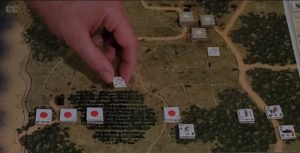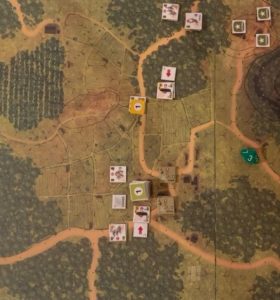Physical Address
304 North Cardinal St.
Dorchester Center, MA 02124
Physical Address
304 North Cardinal St.
Dorchester Center, MA 02124

The tactical, squad-level category is an increasingly crowded one. We have the venerable “grandfather” of tactical games in Advanced Squad Leader, which was an evolution of the much simpler Squad Leader. ASL has a massive following and its DNA is all over many of the tactical games that followed it. But none have really unseated it as the king of the hill for its rabid following (who are vocal and always ready to defend it against the challengers who have cropped up over the years).
But ASL is an older system and as time goes on, innovation emerges that push the envelope and deliver fresh mechanics that push the tactical genre forward. Games like Conflict of Heroes, Lock N Load Tactical, Combat Commander, Combat Infantry, Old School Tactical (yes, the list is getting long and I’m not including nearly everything) have all earned devoted followings of their own.
Into this crowded field a relatively new contender has emerged: The Last Hundred Yards. Designed by Mike Denson and published by GMT Games, LHY (as it will hereafter be called) debuted in 2019. The base game (or volume 1 as some – including me – now call it) featured the U.S. Army and German Wehrmacht in France, following the Normandy landings.
The base game proved successful and garnered some 2019 Charles S. Roberts Award nominations (though it did not win) and currently boasts an 8.1 score on BoardGameGeek. Fittingly, a follow-up was released in 2020, The Last Hundred Yards Volume 2: Airborne Over Europe. And yes, you guessed it, it featured paratroopers – lots of them, including the two famed U.S. Airborne Divisions: the 101st Screaming Eagles and the 82nd All-American. Volume 2 boasts a slightly better 8.2 rating than its parent game on BGG.
2021 saw the release of LHY Volume 3: The Solomon Islands, bringing the system to the Pacific Theatre of Operations. It is this third volume that is the subject of this review.
WELCOME TO THE JUNGLE
The move to the PTO means the debut of both the U.S. Marine Corps and the Imperial Japanese Army in the LHY series as well as a whole new set of terrain – with jungle being the most frequent (and most obvious). The player in LHY assumes the role, essentially, of a Company commander. Depending on the mission the player will have at their disposal one or more platoons of infantry, various support weapons such as machine guns, mortars and anti-tank weapons (and also possibly some flamethrowers too), and armor as well. Yes, there were tanks in the PTO, including the M4 Sherman, although the Japanese had nothing like what the Germans fielded in the ETO.
If you’re wondering what’s in the box, I just happen to have done an unboxing article and video here. I talk about the fabulous components there as well – everything in the box is top-notch and the maps (there are eight of them) are fantastic.
The addition of the Japanese forces to the system brings some new rules. The Japanese were known as fanatical fighters and as designer Mike Denson notes in his design notes, were probably the best light infantry force in the world. They were expert at the type of fighting that would take place on the islands and atolls of the Pacific and gave the Marine Corps and U.S. Army units they faced a brutal and difficult fight, often fighting to the last man.

To simulate the fervor and fighting spirit of the Japanese, Mr. Denson incorporated special rules that include taking a casualty rather than disrupt, which is the result normally associated with a squad that takes damage (the US and German counters flip to their disrupted side and if not recovered can then suffer a casualty on a subsequent hit). Flipping a Japanese squad does not show a disrupted squad, but instead a reduced one. The Japanese also get an increased maneuver allowance – always being able to move two hexes in reaction while all other nationalities may only move one hex. There are many other exceptions (night combat also is a strength that comes to mind) that lend verisimilitude to the Japanese units.
One of the more immediately noticeable “perks” enjoyed by the Japanese is that each full-strength platoon boasts a fourth squad equipped with knee mortars (basically grenade launchers). The knee mortar allows the Japanese to maximize the use of mortar fire, and it can be used to deploy both high explosive (or HE) rounds and smoke. And smoke can be very useful in helping the Japanese close with their enemy where they can use their assault and envelopment skills to the fullest.
In summation, the addition of the Japanese forces to the series was extremely well-done. They feel unique and they play in a way that feels historical. The Japanese penchant for tenacity in both attack and defense is well-modeled and the American player will have their hands full taking on the IJA.
Lest you think all the focus is on the Japanese… well, it’s not. You’ve got the Marines and they, like the paratroopers of Volume 2, are often elite units which get benefits of their own. Much needed benefits for dealing with those tenacious Japanese.
Elite units enjoy an easier time of obtaining “coordination” – which allows multiple platoons to be activated at once. They also have an easier time with cohesion checks, recovery and withdrawal rolls. And their armored units get a little extra toughness with a +1 to their armor value.
The missions fit the theater: the Solomon Islands campaign was centered, as many know, around the island of Guadalcanal. The missions vary from patrols, to finding a lost patrol, to the Japanese attempts to clear the Americans and retake Henderson Field. There are 10 missions in all, and there is also a Do-Your-Mission form at the back of the rule book that you can use to roll up your own missions with a menu of unit types to purchase so each side can have its own customized force.
Another thing that fits the theme and makes this a thrill for two-players: hidden units. Several missions have one or sometimes both set up hidden. This means you’re sort of bumbling your way through the jungle. Which is not a fun activity when the enemy is waiting for you… somewhere in all that foliage. And with the Marines packing flamethrowers and the Japanese having those nasty knee mortars, the surprises in this South Pacific jungle are most definitely not pleasant.
If you’re familiar with either the base game or Volume 2, you’ll recognize the mechanics that make this series so damn good. If you’re new to the series, then I’ll attempt to explain what makes LHY special:

Fire Resolution: this is where you resolve your attacks (duh, right?). You get dice-roll-modifiers in three flavors: small arms, mortar and anti-tank. And they come in stop light colors: SADRM markers are green, ATDRM are yellow and, yep you guessed it, MDRM are red. Probably because mortars go boom (unless they’re laying down some smoke of course). The resolution of fire feels right too as units get disrupted and the attack effects the whole hex, but only one unit can be hit in any round. It keeps things feeling realistic. Units under fire learn pretty quickly to go to ground and protect themselves – war is not a Hollywood movie.
Bottom line is I think this is a great tactical system. Mike Denson and GMT are putting out a fourth volume on the Russian Front (Soviets vs Germans? Yes, please!). That, a mission pack and the original game are all on P500 right now. I’ve got my order placed. I can’t wait to see where the series goes next… after playing some more in the PTO and experiencing this system on the steppes of Mother Russia.
I did a playthrough, showing several game mechanics including anti-tank and assault on my YouTube channel here.
You can purchase the game from GMT Games’ website, here.